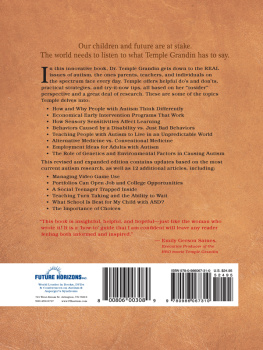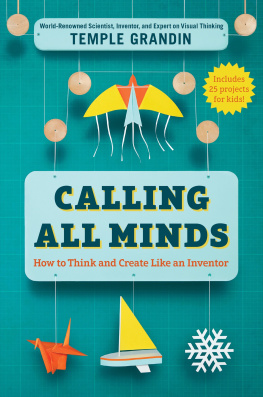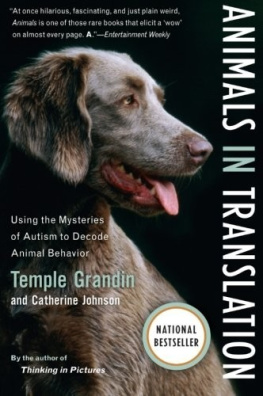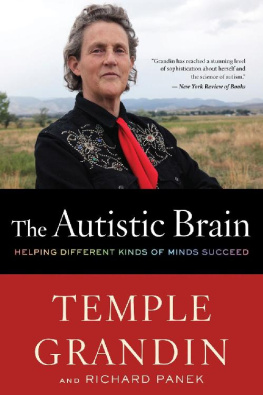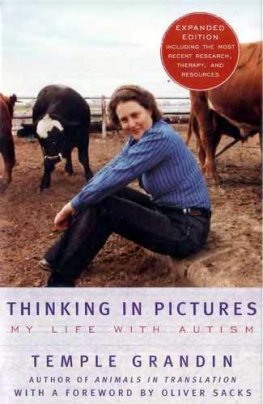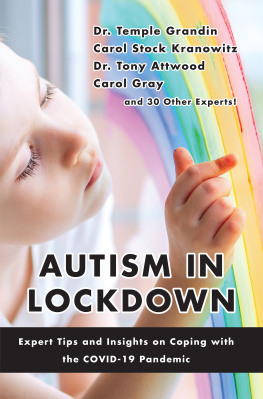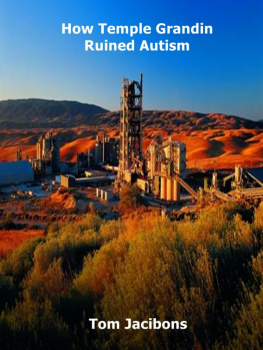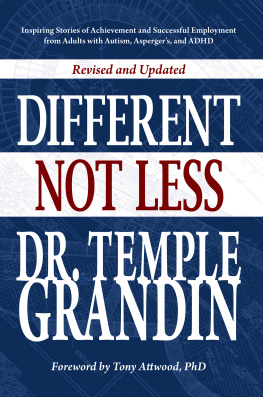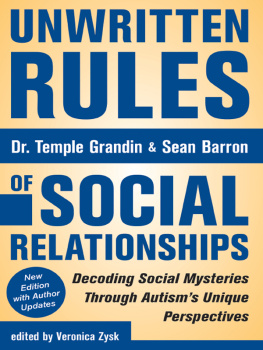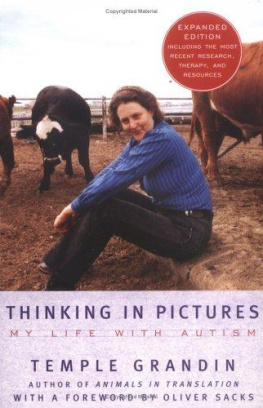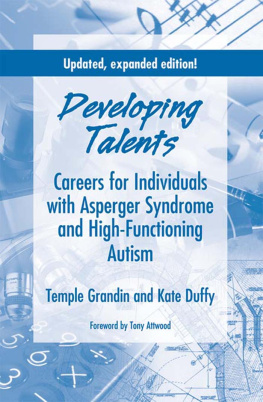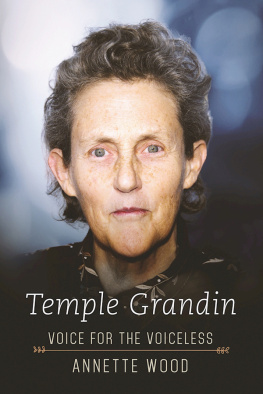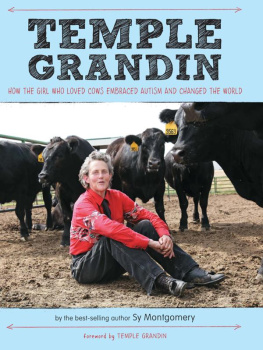Temple Grandin - The Way I See It: A Personal Look at Autism and Aspergers
Here you can read online Temple Grandin - The Way I See It: A Personal Look at Autism and Aspergers full text of the book (entire story) in english for free. Download pdf and epub, get meaning, cover and reviews about this ebook. year: 2013, publisher: Future Horizons, genre: Children. Description of the work, (preface) as well as reviews are available. Best literature library LitArk.com created for fans of good reading and offers a wide selection of genres:
Romance novel
Science fiction
Adventure
Detective
Science
History
Home and family
Prose
Art
Politics
Computer
Non-fiction
Religion
Business
Children
Humor
Choose a favorite category and find really read worthwhile books. Enjoy immersion in the world of imagination, feel the emotions of the characters or learn something new for yourself, make an fascinating discovery.
- Book:The Way I See It: A Personal Look at Autism and Aspergers
- Author:
- Publisher:Future Horizons
- Genre:
- Year:2013
- Rating:3 / 5
- Favourites:Add to favourites
- Your mark:
- 60
- 1
- 2
- 3
- 4
- 5
The Way I See It: A Personal Look at Autism and Aspergers: summary, description and annotation
We offer to read an annotation, description, summary or preface (depends on what the author of the book "The Way I See It: A Personal Look at Autism and Aspergers" wrote himself). If you haven't found the necessary information about the book — write in the comments, we will try to find it.
The Way I See It: A Personal Look at Autism and Aspergers — read online for free the complete book (whole text) full work
Below is the text of the book, divided by pages. System saving the place of the last page read, allows you to conveniently read the book "The Way I See It: A Personal Look at Autism and Aspergers" online for free, without having to search again every time where you left off. Put a bookmark, and you can go to the page where you finished reading at any time.
Font size:
Interval:
Bookmark:

The Way I See It:
A Personal Look at Autism & Aspergers
All marketing and publishing rights guaranteed to and reserved by:

721 W Abram St, Arlington, TX 76013
800-489-0727 (toll free)
817-277-0727 (local)
817-277-2270 (fax)
E-mail:
www.fhautism.com
2014 Temple Grandin
Cover and interior design, John Yacio III
All rights reserved.
Printed in the United States of America.
Photos Rosalie Winard: Cow photo in chapter title collage, author bio, and central photos on titles for chapters .
title image Angus Bremner.
No part of this product may be reproduced in any manner whatsoever without written permission of Future Horizons, Inc, except in the case of brief quotations embodied in reviews.
This book is unedited for content. Any opinions are those of the author and are not necessarily shared by the publisher.
ISBN: 978-0-986067-31-0 E-ISBN: 978-1-941765-02-9


T emple has an autism spectrum disorder (ASD) and is a world-renowned animal scientist and author. She also entrances audiences with her insights and explanations of autism, based on her personal experiences and knowledge of the research literature. She is a very forthright person, and I can hear her voice on every page of The Way I See It. Temple is a hero of mine, and I have great respect for her understanding of the vast and diversified spectrum of autism.
I was eager to read Temples latest publication, a compilation of articles for the Autism Aspergers Digest over almost 15 years. She covers a wide range of topics across the entire autism spectrum, from self-injurious behaviour for those who have severe autism to religious education and employment. There is wisdom on every page, and I know that parents, professionals, and especially teachers will achieve a greater appreciation of the world as perceived and experienced by those who have an ASD.
I know that I will be taking quotations from The Way I See It to illustrate specific points in my presentations, and I will be advising colleagues that their expertise will be greatly enhanced by reading Temples explanations and recommendations. I also recommend that those who have an ASD read Temples new book to achieve validation and learn practical strategies to encourage specific abilities.
Temple has a phenomenal and encyclopaedic knowledge of ASDs, and, in reading The Way I See It, you will see autism the way it is.
DR. TONY ATTWOOD
New to Autism

A utism is a developmental disorder, typically diagnosed during early childhood. It is neurological in nature, affecting the brain in four major areas of functioning: language/communication, social skills, sensory systems, and behavior. Current research suggests there may be different subsets of the disorder arising from genetics, environmental insults, or a combination of both.
Every person with autism is unique, with a different profile of strengths and challenges. No two individuals manifest the same characteristics in the same degree of severity. It is a spectrum disorder, and the various individual diagnoses are collectively referred to as autism spectrum disorder (ASD). Individuals on the spectrum range from those who are nonverbal with severe challenges that can include self-injurious behaviors and intellectual disability to individuals on the higher-functioning end of the spectrum (known as Aspergers Syndrome) who are extremely intelligent, with good expressive verbal language, yet markedly impaired social skills and weak perspective-taking abilities. The autism spectrum is very broad, ranging from socially awkward brilliant workers in Silicon Valley to individuals who will always have to live in a supervised living situation. Some kids on the high end of the autism spectrum are gifted in art, music, or mathematics. In 2013, changes were made in diagnostic criteria in the DSM (Diagnostic and Statistical Manual of Mental Disorders), the diagnostic bible of the medical community, which eliminated Aspergers Syndrome. The various autism labels are now merged into one designation, Autism Spectrum Disorders.
The rate of autism is now 1 in every 100 births (Centers for Disease Control, 2009) and continues to escalate at alarming rates. Every 21 minutes a child is diagnosed on the spectrum. It is four times more common in boys than girls, and is consistently prevalent around the globe, and within different racial, social, and ethnic communities. According to the Autism Society of America, the lifetime cost of caring for a single child with severe autism ranges from $3.5 to $5 million.
Autism is a different way of thinking and learning. People with autism are people first; autism is only one part of who they are. ASD is no longer viewed as strictly a behavioral disorder, but one that affects the whole person on various fronts: biomedical, cognitive, social, and sensory. With individualized and appropriate intervention, children with ASD can become more functional and learn to adapt to the world around them.
Great strides are being made in our understanding of autism spectrum disorders and how best to help these individuals. Children are now being diagnosed as early as 12-15 months old, and many who receive intensive early intervention are able to enter elementary school in class with their typical peers, needing minor supports and services. No matter the age of diagnosis, children and adults with ASD are constant learners and significant improvements in their functioning can be made at any age with the appropriate types and intensity of services.
(Autism Aspergers Digest, 2008. Reprinted with permission. Revised 2014)
1. Autism Society of America Web site, www.autism-society.org

T his third edition of this book is a compilation of articles I have written for the Autism Aspergers Digest magazine from 2000 to the present. The articles have been grouped into different categories, addressing subjects from early educational interventions, to sensory sensitivity problems, to brain research and careers. At the beginning of each section I have added a new, updated introduction, which includes additional thoughts on the subject matter. Articles that required updating were updated.
The articles combine both my personal experiences with autism and practical information that parents, teachers, and individuals on the autism spectrum can put to immediate use. The autism spectrum is very broad, ranging from individuals who remain nonverbal to a mild Aspergers individual who is a brilliant scientist or computer engineer. This book contains information that can be applied across the entire autism spectrum.
Font size:
Interval:
Bookmark:
Similar books «The Way I See It: A Personal Look at Autism and Aspergers»
Look at similar books to The Way I See It: A Personal Look at Autism and Aspergers. We have selected literature similar in name and meaning in the hope of providing readers with more options to find new, interesting, not yet read works.
Discussion, reviews of the book The Way I See It: A Personal Look at Autism and Aspergers and just readers' own opinions. Leave your comments, write what you think about the work, its meaning or the main characters. Specify what exactly you liked and what you didn't like, and why you think so.

